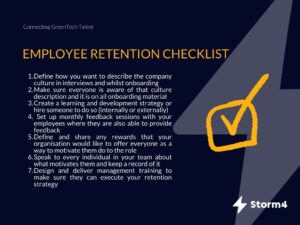Tips For High Employee Retention Rates For GreenTechs In Asia
According to XpertHR , the average turnover of employees in the technology sector is 3.9%. If your organisation’s turnover rate is higher then this, you have a great opportunity to gain competitive advantage by holding on to your best talent. The goal isn’t to reduce your staff turnover to 0%, as some turnover is a good thing (i.e. making sure you are bringing in fresh talent to help improve the business). However, we do want to remove any unwanted attrition. This article will look at the importance of putting a concerted effort into retaining your best talent, why people leave a business and the steps you can implement today to improve your employee retention.
Reasons Why People Leave Their Company
Having asked our database of 2,000 candidates why they are looking for new opportunities, the main reasons are depicted in the graph below:

Statistics On Why People Leave Their Current Company
 Set Real Expectations In Interviews And Onboarding
Set Real Expectations In Interviews And Onboarding
One of the standout figures is that a large amount of employees leave due to company culture. However, they chose to work for that company at some point. So the root cause of that issue must either be that they weren’t made aware of what the company culture was before they joined, or it didn’t meet what they were told.
Whilst it is important to sell the company during the interview and onboarding process, you need to give a realistic expectation of the culture. If you feel your culture will put off the majority of the type of candidates you would like to hire, then you may want to work on the culture itself.
You also need to make sure any recruiting and onboarding material and all of those involved in the interview and onboarding process are in sync with what they portray the culture as. So train everyone involved in what the culture is and ask candidates after they have been through the process to define the company culture to see if it matches.
Create An Official Training Program And Make Sure Everyone Has The Right Tools To Do The Job
This is the most time consuming and expensive retention tool, but with 50% higher retention rates in companies that have a strong learning culture, one of the most important. This will also improve company performance as employees will be able to do their jobs better.
There are plenty of companies that will provide training for you, such as Learnably. You may want to consider hiring a Head of Learning and Development or someone similar whose responsibility it is to create a training culture (or give the responsibility to somebody already in the business such as a HR Manager or COO).
Provide And Ask For Regular Feedback
A high number of employees leave their roles because they don’t feel valued. Providing regular feedback demonstrates that you are willing to put in the time to develop each employee, and show they are an important part of your organisation. As a minimum you should be providing feedback on an employee’s performance once a month, and you can use techniques such as the “Start, Stop, Continue” method to provide effective feedback.
In these feedback sessions, it is also a great time to allow for them to provide you with feedback on how they feel their role is going. In our analysis, the second biggest reason why people are looking to move is because they want a new challenge. If they make you aware this is the case in feedback sessions, you can give them extra responsibilities to make their role more challenging.
Motivate The Group
Think about the rewards you offer to the entire business and whether those are the right rewards to motivate everyone. The best way to find this out is to simply ask people what they think may work best. For example, you could get a focus group of 10-15 people across the business to share their ideas.
Also speak to other companies and understand what they are doing to motivate their employees and the rewards they offer. The research shows that flexible working is one that a lot of employees look for. We have seen many different versions of this, with the most popular two being working from home or having core office hours but flexibility around any other time spent in the office. For example, you may say to the team they need to be in the office between 10am and 3pm, and they need to work 40 hours a week. So if they are only in 10am to 3pm in one day, they can just work a longer day another day to make up the hours.
Another popular motivation tactic is clear and often progression steps. Not being able to progress is a huge reason why candidates come and speak to us to find a new role, and that is because their next step in their organisation is 3 to 5 years away. Try and find a way of progressing your team at the most every 2 years (assuming they are performing well enough to progress). You might do this by introducing a Senior title, who has mentorship responsibilities over junior members of the team, but not yet managerial responsibility. You might ask others to lead project teams as part of their progression. Every time someone steps into a position, they should clearly see what their next step is, see that is close enough and know what they need to do to achieve it.
Motivate The Individual
Whilst it is important to have rewards that are uniform across the business, it is also important to know what motivates each individual person.
It’s vital that every manager sits down with each member of their team and gets a deep understanding of what they are looking for out of this job, out of their time at your company and out of their career. That might lead you to put them on a fast track training course externally to become leadership or allowing them flexible working time to come in slightly later on a couple of days so they can do the school run.
One of the best examples of this being done well is a manager who used to keep a spreadsheet of all their team member’s motivations, and also what their Starbucks order was. That way, if they had done well, they would nip out to Starbucks and get them their favourite drink, put it on their desk next to them and say, “thank you”. A simple yet incredibly effective way to motivate the individuals in your team.
Management Training
The saying goes that people “don’t leave companies, they leave managers”. Whilst in reality it is much more complicated then that, the management is the front line of activity that can cause you to have a positive or negative retention. So how and when they execute those activities is vital.
For example, you can have the best flexible working options, but if their manager says they cannot work flexibly then it won’t work. If you have agreed how to describe the culture of the organisation in an interview, but the manager doesn’t then describe it correctly in the interview itself, expectations won’t be set correctly.
Therefore investing time and money into training your managers to be good managers is key to your retention strategy.

In conclusion, GreenTech businesses in Asia must prioritize staff retention if they want to be competitive in a market that is expanding quickly. Companies can retain their top people and guarantee long-term success by developing a healthy workplace culture, providing competitive compensation packages, encouraging work-life balance, enabling chances for growth and development, and recognizing and rewarding employee accomplishments.
We Are Here To Help
Whether you are a small start-up or looking to scale up, Storm4 is here to support your growth journey. We are specialist recruiters dedicated to working with the top companies in all GreenTech sectors. Storm4 is here to help you find the right senior talent for the right specialism. If you are looking to expand your team, contact us.



 Set Real Expectations In Interviews And Onboarding
Set Real Expectations In Interviews And Onboarding 







